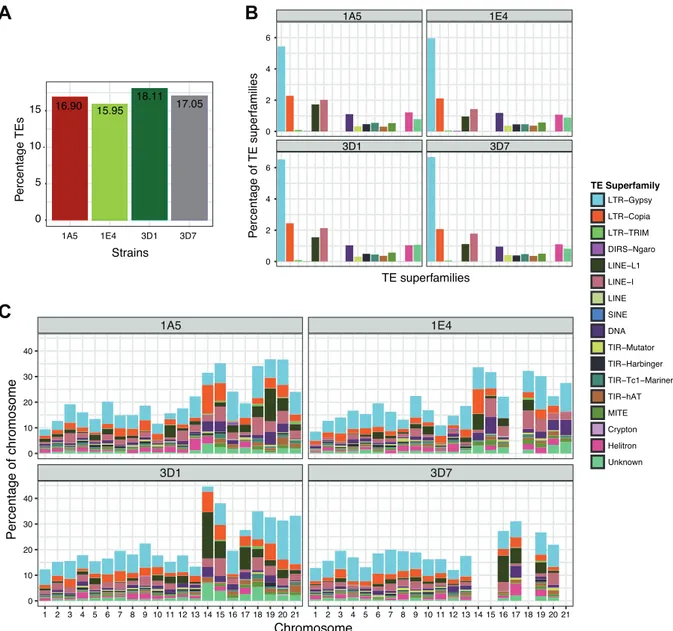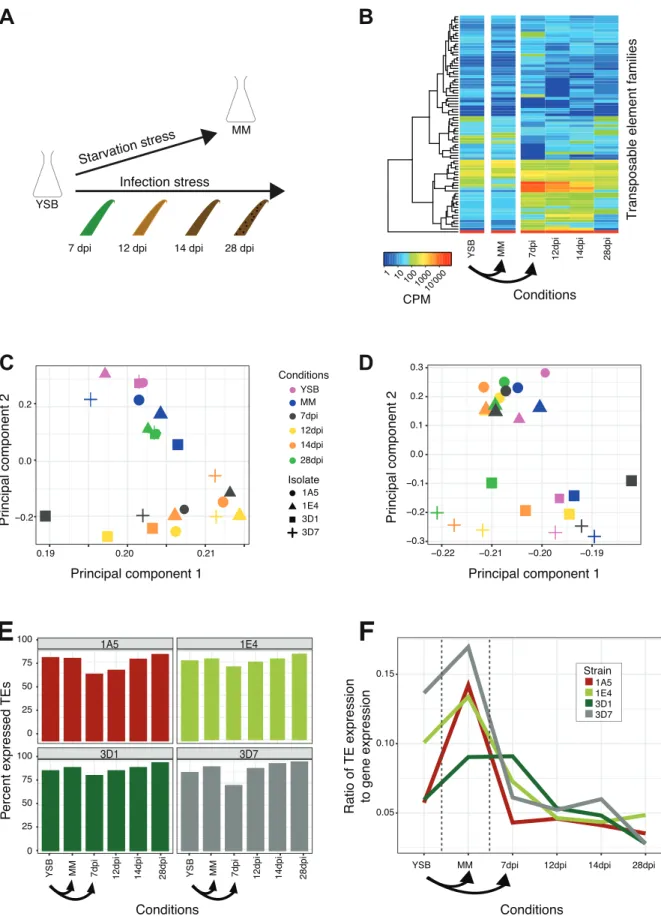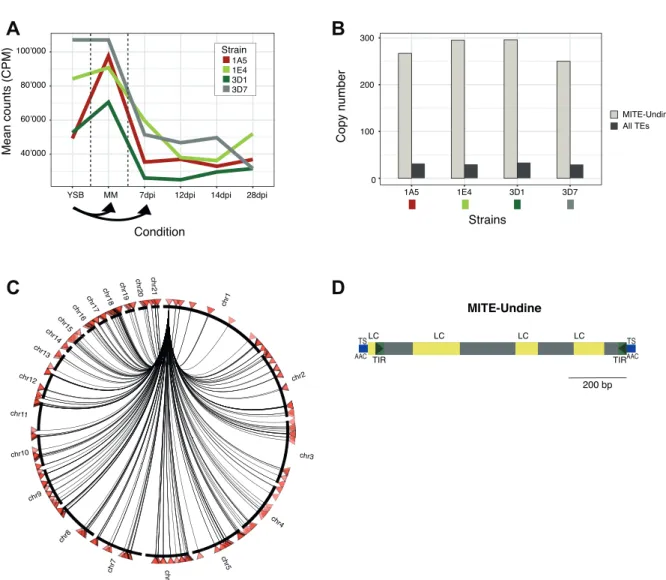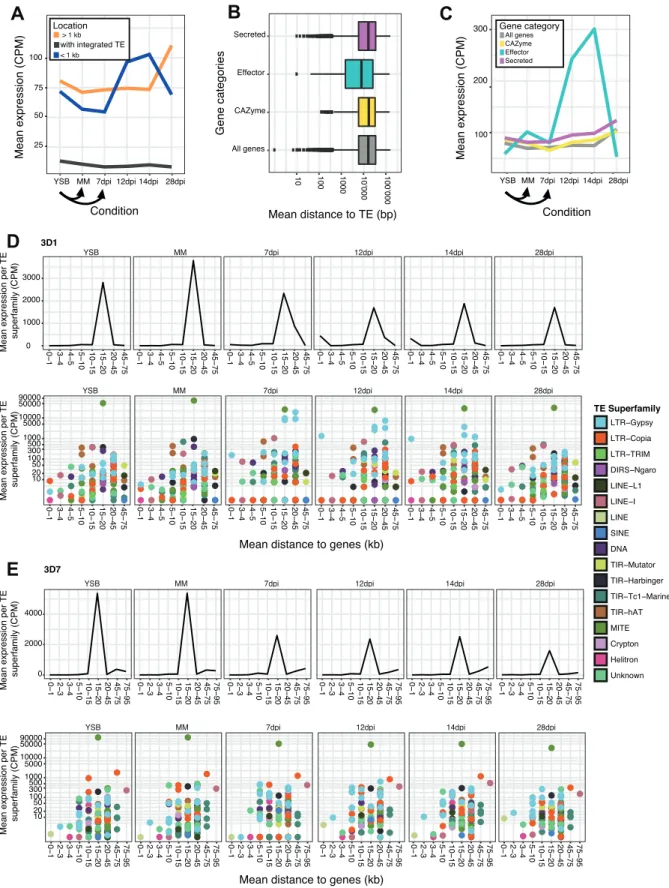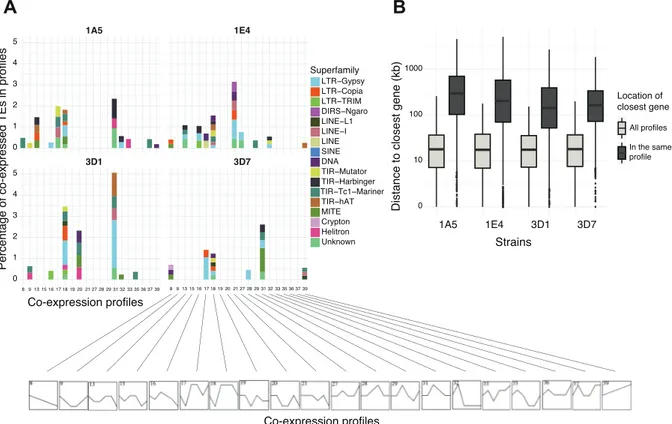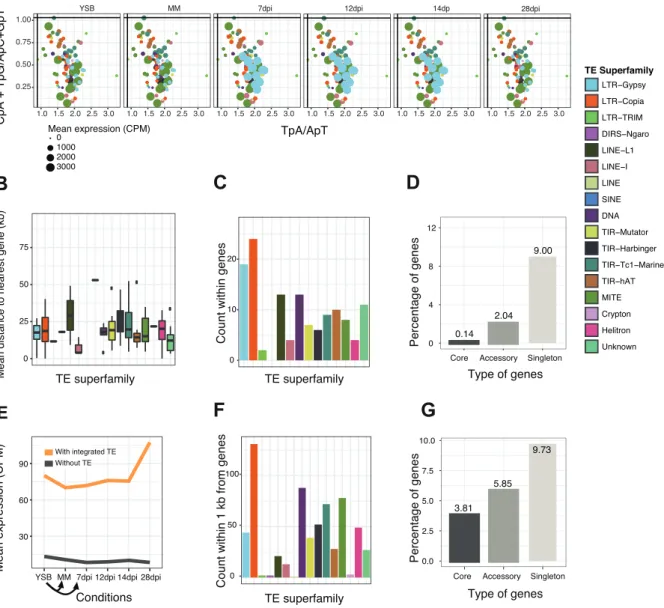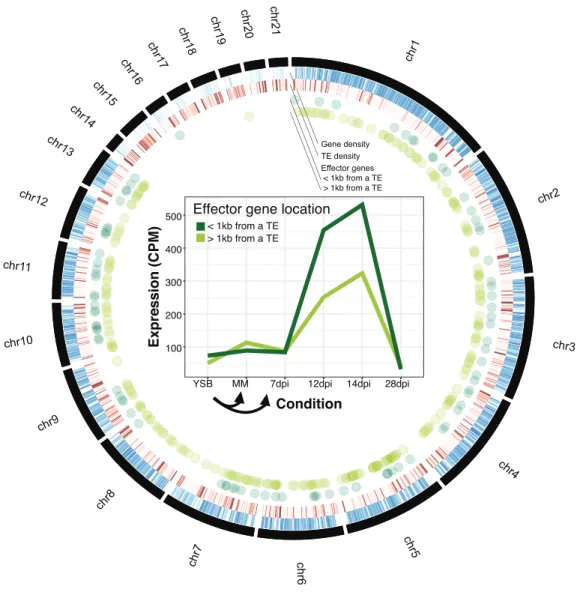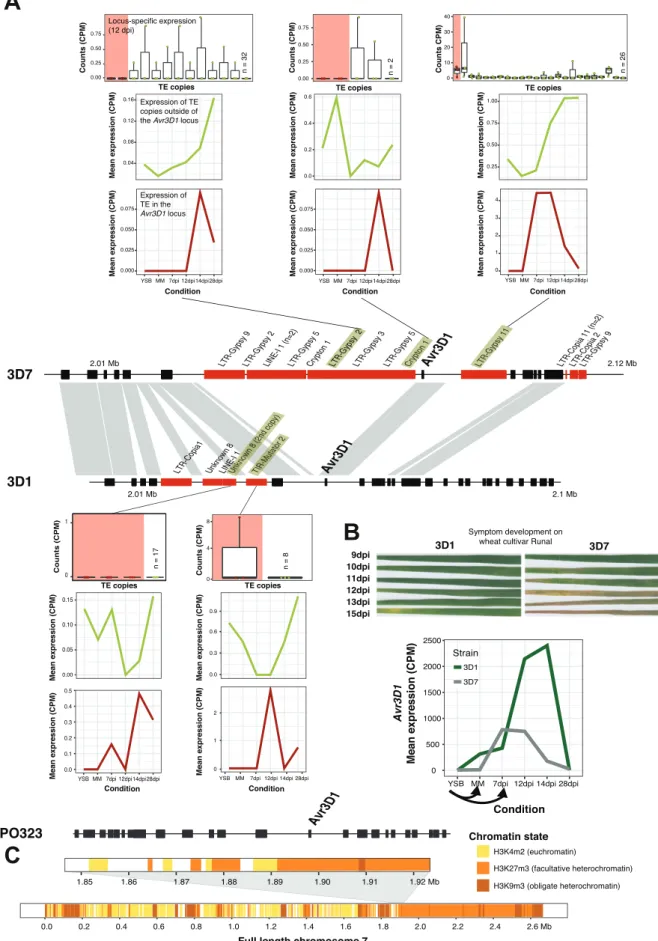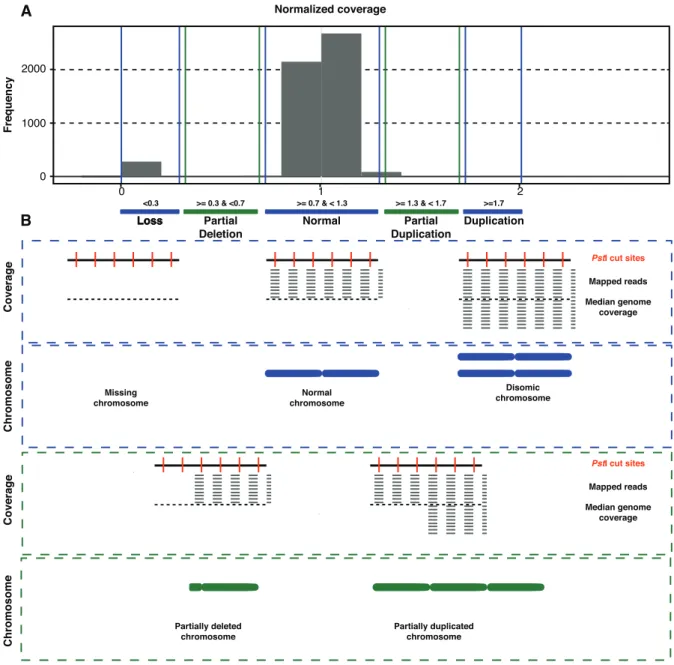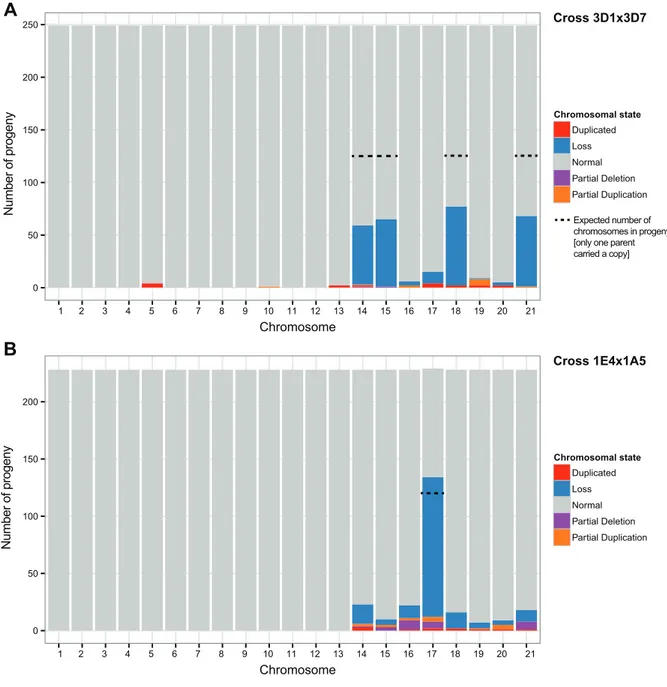Research Collection
Doctoral Thesis
Drivers of genome evolution in a fungal pathogen of wheat
Author(s):
Fouché, Simone Publication Date:
2020
Permanent Link:
https://doi.org/10.3929/ethz-b-000425971
Rights / License:
In Copyright - Non-Commercial Use Permitted
This page was generated automatically upon download from the ETH Zurich Research Collection. For more information please consult the Terms of use.
DISS. ETH NO.26555
DRIVERS OF GENOME EVOLUTION IN A FUNGAL PATHOGEN OF WHEAT
A thesis submitted to attain the degree of DOCTOR OF SCIENCES of ETH ZURICH
(Dr. sc. ETH Zurich)
presented by SIMONE FOUCHÉ
Master of Science in Microbiology, University of Pretoria Born on 02.01.1989
Citizen of South Africa accepted on the recommendation of
Prof. Dr. Bruce McDonald Prof. Dr. Daniel Croll Prof. Dr. Alexander Suh
2020
TABLE OF CONTENTS
SUMMARY ... vii
ZUSAMMENFASSUNG ... ix
GENERAL INTRODUCTION ... 1
• Genome evolution and transposable elements ... 3
• Main questions and outlines for this PhD thesis: ... 7
• References ... 11
CHAPTER 1: ... 18
• Stress-driven transposable element de-repression dynamics and virulence evolution in a fungal pathogen ... 18
• Abstract ... 20
• Introduction ... 21
• Results ... 26
TE landscape and transcriptomic response to stress conditions ... 26
Differential stress response dynamics of TEs across environments ... 28
TE and gene expression dynamics as a function of the genomic localization ... 31
Co-expression networks of genes and TEs across stress conditions ... 34
Impact of genomic defenses on TE expression under stress ... 35
TE insertion dynamics in proximity to genes ... 38
Impact of TE de-repression dynamics on virulence ... 38
• Discussion ... 44
Stress-dependent TE de-repression dynamics ... 44
TE and gene co-expression dependent on the genomic environment ... 46
The role of the genetic background in TE expression dynamics ... 47
Stress de-repression of TEs and the evolution of TE control mechanisms ... 48
• Materials and methods ... 50
Strains and growth conditions ... 50
Gene and repetitive element annotation ... 50
RNA extractions, library preparation and sequencing ... 51
Transcription mapping and quantification ... 52
Locus-specific TE expression between 3D1 and 3D7 ... 53
Genomic localization of TEs and co-expression analyses ... 54
RIP analysis ... 54
• Acknowledgements ... 56
• Author contributions ... 56
• References ... 57
• Supplementary Information ... 71
• Supplementary Figures ... 72
• Supplementary Files ... 101
• Supplementary Tables ... 102
CHAPTER 2: ... 105
• Meiosis leads to pervasive copy-number variation and distorted inheritance of accessory chromosomes of the wheat pathogen Zymoseptoria tritici ... 105
• Abstract ... 107
• Introduction ... 108
• Materials and Methods ... 112
Generation of sexual crosses ... 112
Reference alignment using restriction site-associated DNA sequencing ... 113
Determining chromosome number and length polymorphisms based on coverage ... 114
Distinguishing between homozygous and heterozygous disomy ... 116
Chromosome instability and recombination rate, chromosome length, synteny and transposable element content of the parent chromosomes ... 116
Analyses of progeny phenotypes ... 117
• Results ... 118
Mapping RADseq reads to the reference genome ... 118
Patterns of chromosome transmission in the two crosses ... 119
Meiosis generates novel chromosome length polymorphism ... 123
Correlation of chromosomal features with the fidelity of transmission ... 125
Association between accessory chromosomes and phenotypic traits ... 128
Correlation between disomy and chromosomal rearrangements ... 129
• Discussion ... 131
• Acknowledgments ... 138
• References: ... 139
• Supplementary Information ... 145
• Supplementary Figures ... 146
• Supplementary Tables: ... 153
CHAPTER 3: ... 154
• Repeated chromosomal degeneration through repeat-induced chromosomal rearrangements in a fungal pathogen ... 154
• Abstract ... 156
• Introduction ... 157
• Materials and Methods ... 161
Performing crosses ... 161
DNA extraction ... 163
Library preparation ... 164
Genome assembly using self-corrected PacBio long reads. ... 164
Annotation of coding sequences and repetitive elements ... 165
Assembly of chromosome 17 ... 165
Chromosome 17 segment PCR assay ... 166
Preparation of fungal material for molecular karyotyping ... 167
Pulsed-field gel electrophoresis ... 168
Southern transfer and hybridization of pulsed-field gels ... 168
• Results ... 170
Assembly and annotation of progeny genomes across the pedigree ... 170
Identification of a major reciprocal translocation event ... 171
Chromosomal rearrangements and initiation of breakage-fusion-bridge cycles ... 172
Sustained chromosome degeneration in subsequent rounds of meiosis ... 175
Discussion ... 186
• References ... 189
• Supplementary Information ... 197
• Supplementary Figures ... 198
• Supplementary Tables ... 217
CHAPTER 4: ... 231
• The birth and death of effectors in rapidly evolving filamentous pathogen genomes ……….231
• Abstract ... 233
• Introduction ... 234
Mechanism of effector gene emergence in pathogens ... 236
The birth of new effector genes ... 240
Epigenetic regulation of effector gene expression ... 241
Generating the raw material for within-species effector evolution ... 242
End-of-life stages of an effector in pathogen populations ... 243
• Conclusions and outlook ... 246
• Acknowledgements ... 248
• References ... 249
GENERAL DISCUSSION ... 260
• General discussion and perspectives ... 262
Transposable elements de-repression dynamics, the Dr. Jekyll and Mr. Hyde of pathogen genomes ... 263
Can TE activity and structural variation ultimately lead to genome compartmentalization? ... 265
• References ... 267
ACKNOWLEDGEMENTS ... 270
SCIENTIFIC CONTRIBUTIONS ... 272
Published Work ... 272
Unpublished Work ... 273
Conferences and Presentations ... 274
Curriculum vitae ... 275
• Education and Professional Development ... 275
SUMMARY
Chromosome rearrangements involve duplication, deletions, inversions and translocations.
Breakpoints of chromosome rearrangements are frequently in close proximity to transposable elements (TEs). TEs are known to mediate chromosome rearrangements through their own activity or through ectopic recombination. During this PhD we aimed to better understand the causes and consequences of chromosome rearrangements in Zymoseptoria tritici, an important pathogen of wheat. To study the origins of chromosome rearrangements the first chapter focusses on the de-repression of TEs, which is stress induced during a wheat infection cycle as well as in nutrient limited media. Stress was shown to drive epigenetic changes and trigger TE de-repression in multiple organisms. We find that TEs respond differently to stresses. Furthermore, effector genes in close proximity to TEs show a de-repression during early infection suggesting that TEs and effectors may be under the same epigenetic control. De-repressed TEs can place a mutational burden on the genome. Therefore, in the second chapter we aimed to quantify the number of chromosome rearrangements occurring in all 21 chromosomes in hundreds of progeny through a single round of meiosis. We find that the fidelity with which chromosomes go through meiosis differs between chromosomes. Chromosomes with a higher repeat content and lower synteny were less stable. In the final chapter we focused on a single rearranged chromosome that was generated by a self-fusion. We hypothesized that such a fused chromosome would go through degenerative breakage-fusion-bridge (BFB) cycles. Here we show the exact process whereby the highly unstable fused chromosome was created through ectopic recombination between a specific repeat family. We trace the fate of the novel chromosome through five rounds of meiosis and show that degenerative cycles occur through repeated ectopic recombination and non-disjunction. The ability of Z. tritici to tolerate chromosome duplications, losses and rearrangements makes this species a great
model to observe and investigate the interplay between TE dynamics and chromosome rearrangements.
ZUSAMMENFASSUNG
Chromosomenumlagerungen beinhalten Duplizierungen, Deletionen, Inversionen und Translokationen. Bruchstellen von Chromosomenumlagerungen liegen häufig in unmittelbarer Nähe zu transponierbaren Elementen (TEs). TEs können Chromosomenumlagerungen durch ihre eigene Aktivität oder durch ektopische Rekombination vermitteln. In dieser Arbeit wollten wir die Ursachen und Folgen von Chromosomenumlagerungen bei Zymoseptoria tritici, einem wichtigen Erreger von Weizen, besser verstehen. Um die Ursprünge der Chromosomenumlagerungen zu untersuchen, konzentrierten wir uns im ersten Kapitel auf die Derepression von TEs, die während des Infektionszyklus von Weizen und in nährstoffarmen Medien induziert werden. In mehreren Organismen konnte gezeigt werden, dass Stress epigenetische Veränderungen und TE Derepression auslöst. Wir stellen fest, dass TEs unterschiedlich auf Belastungen reagieren.
Darüber hinaus zeigen Effektorgene in unmittelbarer Nähe zu TEs eine Derepression während einer frühen Infektion, was darauf hindeutet, dass TEs und Effektoren unter der gleichen epigenetischen Kontrolle stehen. Derepressive TEs sind stark mutagen und stellen deshalb eine große Belastung dar für das Genom. Wir haben deshalb im zweiten Kapitel versucht, die Anzahl der Chromosomenumlagerungen zu quantifizieren, die in allen 21 Chromosomen in einer einzigen Runde Meiose in Hunderten von Nachkommen entstanden sind. Wir stellten fest, dass die Genauigkeit, mit der Chromosomen durch die Meiose gehen, sich zwischen Chromosomen unterscheidet. Chromosomen mit einem höheren Gehalt von repetitiven Elementen und einer niedrigeren Syntenie waren instabiler. Im letzten Kapitel konzentrierten wir uns auf ein einzelnes umgelagertes Chromosom, welches durch eine Selbstfusion erzeugt wurde. Wir haben angenommen, dass ein solches fusioniertes Chromosom degeneriert sein würde aufgrund von sogenannten „Bruch-Fusion-Verbindungs- Zyklen“ (engl. breakage-fusion-bridge cycles). Wir konnten den genauen Prozess aufzeigen,
einer bestimmten Familie von repetitiven Elementen erzeugt wurde. Wir verfolgten das Schicksal des neuartigen Chromosoms durch fünf Runden Meiose und zeigten auf, dass degenerative Zyklen durch wiederholte ektopische Rekombination und durch fehlende Disjunktion entstehen. Die Fähigkeit von Z. tritici, Chromosomenduplikationen, Chromosomenverluste und Chromosomenumlagerungen zu tolerieren, macht diese Spezies zu einem großartigen Modell, um das Zusammenspiel zwischen TE-Dynamik und Chromosomenveränderungen zu beobachten und zu untersuchen.
GENERAL INTRODUCTION
Genome evolution and transposable elements
The majority of the eukaryotic genome is organized into linear chromosomes (Timmis et al., 2004). Chromosomes despite the presence of stabilizing centromeres and telomeres are dynamic genetic elements, contributing to genome plasticity through duplications, deletions, rearrangements, translocations and inversions (Coghlan et al., 2005). Hence, genomes are continuously evolving in populations. Most chromosome aberrations are deleterious, but in rare cases they can be beneficial. Aneuploidy or the presence of an additional copy of an additional chromosome has enabled adaptive evolution in some rare cases (Chen et al., 2012; Yona et al., 2012). Breakpoints of chromosome rearrangement are generally found in close proximity to transposable elements (TEs) (Coghlan et al., 2005). TEs are subdivided into two major categories according to their mechanism of transposition. Class I TEs that retrotranspose through an RNA intermediate (i.e. RNA transposons) according to a ‘copy- and-paste’ mechanism (Boeke et al. 1985) and class II TEs that transpose as DNA through a ‘cut-and-paste’ mechanism (i.e. DNA transposons) (Greenblatt and Brink 1963; Rubin et al. 1982) or a ‘peel and paste’ replicative mechanism in the case of Helitrons (Grabundzija et al. 2016). Both classes of TEs are associated with chromosome rearrangements.
Transposable elements are major components of eukaryotic genomes even though the percentage of TEs varies greatly between species.
TEs affect genomes by inserting into and disrupting genes, by introducing chromosomal rearrangements and by altering the epigenetic state and expression profiles of adjacent genes (Hollister & Gaut, 2009; Lim, 1988; Oliver, McComb, & Greene, 2013; Petrov, Aminetzach, Davis, Bensasson, & Hirsh, 2003; Slotkin & Martienssen, 2007). The uncontrolled spread and proliferation of mobile elements can have a fitness cost by bloating the genome size and increasing the likelihood of deleterious ectopic recombination (Chuong et al. 2017; Mita & Boeke 2016). TEs can promote chromosome rearrangements long after
they are no longer able to transpose through recombination between highly similar regions (Carvalho and Lupski 2016). TE insertions rarely provide any fitness advantage to the host and so a major question is why TEs persist through evolution? Hosts have evolved a plethora of mechanisms to control their TEs (Slotkin and Martienssen 2007). Furthermore, natural selection and drift are two of the major forces shaping the TE content in genomes, where strongly deleterious TEs are rapidly removed from the population (Lynch 2007).
Insertions that are close to neutral in terms of their effect on genome function or host fitness can reach fixation by drift. Therefore, the fate of a TE in a genome also depends on some intrinsic properties of the elements, such as insertion site preferences (Bourque et al. 2018).
Plant pathogenic fungi are great models to study TEs and chromosome rearrangements.
Plant pathogenic fungi and oomycetes pose a major risk to food security (Fisher et al. 2012) because of the dynamic nature of their genomes and subsequent ability to rapidly evolve virulence to crops. Fungal genomes are highly polymorphic in terms of karyotype, likely as a result of occurring in such a wide range of habitats (Kistler and Miao, 1992; Zolan, 1995).
Many fungal pathogens have so-called accessory chromosomes that have presence- absence polymorphism within a species and typically accumulate more mutations and structural variations than other regions of the genome (Bertazzoni et al. 2018). Not surprisingly filamentous pathogens show great variability in terms of genome size. This size variation is explained by the accumulation of TEs in some genomes (Raffaele and Kamoun, 2012). TEs are drivers of chromosome length polymorphisms through ectopic recombination during meiosis (Bzymek and Lovett 2001; Argueso et al. 2008; Raskina et al. 2008).
However, the extent to which chromosome rearrangements happens through one round of meiosis and the factors affecting the transmission of chromosomes from one generation to the next are not well characterized.
TEs and chromosome rearrangements have played a role in shaping pathogen genomes.
Many fungal pathogens have a bi-partite genome architecture (Raffaele and Kamoun 2012;
Dong et al. 2016), where so-called effector genes are located in the repeat rich regions of the genome. Effectors are small secreted proteins that play a role in manipulating the host cell and/or interfere with or protect the pathogen from the host’s defenses. Furthermore, effectors have a very characteristic and tightly regulated expression profile during infection, because of playing a highly specific role at a critical point of time (Skibbe et al. 2010; Rouxel et al. 2011; Hacquard et al. 2012; Kleemann et al. 2012; Gervais et al. 2016; Palma- Guerrero et al. 2016). TE rich regions are hotspots for mutations, gene deletions and alterations to the expression profiles of existing effectors as well as the emergence of new effectors which can contribute to gains in virulence (Presti et al. 2015). Furthermore, RIP (repeat-induced point mutation) is a fungal specific premeiotic genomic defense mechanism that targets and mutates TEs and other repeated sequences and has been shown to contribute to effector diversification in Leptosphaeria maculans (Galagan and Selker 2004;
Rouxel et al. 2011). In addition, effector genes can benefit from their co-localization with TEs because there appears to be a relationship between the de-repression of TEs and the expression of effectors. Specifically, the expression of effectors is often governed by de- repression of facultative heterochromatin (Connolly et al. 2013; Qutob et al. 2013; Chujo and Scott 2014; Soyer et al. 2014; Schotanus et al. 2015; Soyer et al. 2015; Studt et al. 2016).
Regions of facultative heterochromatin encoding effectors overlap with TEs (Soyer et al.
2015; Seidl and Thomma 2017). TE transcription levels are influenced by epigenetic silencing of the host genome and environmental stimuli such as stress, but the underlying mechanisms are poorly understood.
Zymoseptoria tritici is an important pathogen of wheat with a highly dynamic genome containing 13 core and up to eight accessory chromosomes (Goodwin et al., 2011). The
chromosomes that have presence-absence polymorphism within the species (Goodwin et al.
2011). Accessory chromosomes frequently undergo chromosomal rearrangements with breakpoints overlapping with TE insertions (Croll et al. 2013; Plissonneau et al.
2016, 2018; Hartmann et al. 2017). Furthermore, Z. tritici reproduces sexually at least once per wheat growing season (Kema et al., 1996), providing the means for losses, duplications, disomy and other rearrangements to occur during either meiosis or mitosis (Wittenberg et al., 2009; Croll et al., 2013). Z. tritici tolerates extensive chromosome length and number polymorphisms, including whole chromosome losses and disomy (Wittenberg et al., 2009), making it an ideal model for the study of different aspects of genome plasticity and transposable element dynamics.
Main questions and outlines for this PhD thesis:
In this PhD project, I aim to identify the causes and consequences of chromosomal rearrangements in the fungal pathogen model organism Z. tritici.
To understand the origins of TE-mediated chromosomal rearrangements, in my first chapter I focus on factors driving the activation or repression of TEs in the genome. Stress has been shown to trigger epigenetic changes which result in TE de-repression (Miousse et al. 2015).
My first chapter focuses on the relationship between TE de-repression dynamics and stress. TE responsiveness to stress can increase TE transcription and transposition levels, driving bursts of activity of certain TE families and many new TE insertions (Dubin et al.
2018). Plant pathogens such as Z. tritici experience distinct stressors both on the host and off the host. Host defense mechanisms significantly alter the biotic environment for an attacking pathogen. Pathogens also likely face starvation stress after depleting resources on the host or during resting stages outside of the host. Hence, I investigated how TE expression is shaped by these specific stress factors.
The responsiveness of TEs to stress places as mutational burden on the host genome. TEs and their activity are drivers of chromosome rearrangements such as duplications, deletions, inversion and translocations. Hence, my second chapter focuses on quantifying the number of whole chromosome losses, duplications and rearrangements occurring in a single round of meiosis focusing on all of the 21 chromosomes in hundreds of progeny isolates. We also identify mechanisms affecting the fidelity with which chromosomes go through meiosis.
Having established general patterns that shape the faithful transmission of chromosomes, I focus in my third chapter on one massive, serendipitously discovered chromosome rearrangement. The chromosome appeared to be a self-fusion resulting in the amplification of a large segment of the chromosome. We hypothesized that such a fused chromosome would go through degenerative (breakage-fusion-bridge (BFB) cycles). Here we wanted to understand the exact process whereby highly unstable fused chromosomes are created and degenerate.
Given the focus on plant pathogens in this work, I wanted to provide a broader context how TE activity and chromosomal rearrangements can ultimately contribute to virulence evolution. Chapter four constitutes a short review focusing on how effector genes emerge and are lost in pathogen genomes by linking chromosome rearrangements to effector gene evolution as a consequence of chromosome rearrangements. I conclude with a general conclusion and perspective.
For my three main experimental chapters, I am now addressing the following research questions in more detail:
1. What is the impact of stress on transposable element de-repression on an infection cycle in wheat?
2. What are the factors that affect the fidelity of chromosomal inheritance through meiosis?
3. What are the mechanisms underlying the formation of an enlarged chromosome 17 and how does the new chromosome degenerate through breakage-fusion-bridge cycles?
Chapter 1 describes how I used transcriptome profiling to test for the impact of two major stress factors in the life-cycle of the pathogen on TE de-repression, namely nutrient deprivation stress and infection stress. My setup included transcriptomes of Z. tritici from a nutrient-rich culture medium as a non-stress environment and from a nutrient-deprived medium that simulates starvation. I also analyzed the fungal transcriptome at four distinct stages during the infection of wheat spanning the early symptomless stage, the peak of lesion formation and the saprotrophic stage. I replicated the two stress experiments with four genetically distinct strains of Z. tritici to identify how the genetic background influences TE responsiveness. TEs showed the highest de-repression under nutrient stress, but the expression differed significantly between TE families and between genetic backgrounds.
During infection stress, a large number of TE families were de-repressed at the peak of symptom development on wheat leaves. Hereafter, I determined how the genomic location affected the de-repression dynamics of TEs and identified distinct patterns depending on the type of stress, the distance to the closest genes and the impact of genomic defense mechanisms. Finally, I analyzed a locus segregating variation at a key effector gene involved in host adaptation for the impact of TE de-repression. I show that the insertion of specific TEs led to silencing and in turn promoting virulence.
Chapter 2: In this study, I analyze the mechanisms that affect the fidelity of chromosomal inheritance through meiosis. For this I identified chromosomal rearrangements, losses, and duplications by screening hundreds of progeny genotypes generated from two independent crosses. I determined the rate of aneuploidy, patterns of rearrangement and distortions in
transmission rates. Chromosomal duplications (disomy) rarely occurred in the core chromosomes, while accessory chromosomes showed high frequencies of disomy.
However, chromosomal rearrangements were found to occur only on accessory chromosomes and were even more frequent than disomy. Accessory chromosomes present in only one of the parents in one cross were inherited significantly more frequently than the expected 1:1 segregation ratio. Hereafter, I investigated whether factors such as length similarity, synteny, recombination rate, and repetitive element content affected the accuracy with which chromosomes were inherited. Both the chromosome and the parental background had affected the rates of disomy, losses, rearrangements, and distorted inheritance. Chromosomes with higher sequence similarity and lower repeat content were inherited more faithfully.
Chapter 3: In this study, I analyze the mechanism whereby a novel enlarged chromosome 17 is created and how the chromosome degenerates through four rounds of meiosis. We sequence twelve progeny genomes to track the sequence changes as this chromosome goes through degenerative cycles. Crosses were performed between isolates selected specifically to determine the effect of sequence and length similarity on the fidelity with which the novel chromosome goes through meiosis. We performed the fourth generations of crosses to determine if the chromosome 17 variants would stabilize or continue to degenerate. This study provides insights into the mechanisms generating a highly unstable chromosome through ectopic recombination involving transposable elements. Degeneration progresses through a combination of non-homologous recombination and non-disjunction.
The process is fairly random as progeny from the same cross had different derivatives of chromosome 17, but also to some extent predictable as the same TE family and chromosome regions were almost always involved.
References
Argueso JL, Westmoreland J, Mieczkowski PA, Gawel M, Petes TD, Resnick MA. 2008.
Double-strand breaks associated with repetitive DNA can reshape the genome. Proc.
Natl. Acad. Sci. U. S. A. 105:11845–11850.
Bertazzoni S, Williams AH, Jones DA, Syme RA, Tan K-C, Hane JK. 2018. Accessories Make the Outfit: Accessory Chromosomes and Other Dispensable DNA Regions in Plant-Pathogenic Fungi. Mol. Plant-Microbe Interact. MPMI 31:779–788.
Boeke JD, Garfinkel DJ, Styles CA, Fink GR. 1985. Ty elements transpose through an RNA intermediate. Cell 40:491–500.
Bourque G, Burns KH, Gehring M, Gorbunova V, Seluanov A, Hammell M, Imbeault M, Izsvák Z, Levin HL, Macfarlan TS, et al. 2018. Ten things you should know about transposable elements. Genome Biol. 19:199.
Bzymek M, Lovett ST. 2001. Instability of repetitive DNA sequences: the role of replication in multiple mechanisms. Proc. Natl. Acad. Sci. U. S. A. 98:8319–8325.
Carvalho CMB, Lupski JR. 2016. Mechanisms underlying structural variant formation in genomic disorders. Nat. Rev. Genet. 17:224–238.
Chen G, Rubinstein B, Li R. 2012. Whole chromosome aneuploidy: Big mutations drive adaptation by phenotypic leap. BioEssays 34:893–900.
Chujo T, Scott B. 2014. Histone H3K9 and H3K27 methylation regulates fungal alkaloid biosynthesis in a fungal endophyte-plant symbiosis. Mol. Microbiol. 92:413–434.
Chuong EB, Elde NC, Feschotte C. 2017. Regulatory activities of transposable elements:
from conflicts to benefits. Nat. Rev. Genet. 18:71–86.
Coghlan A, Eichler EE, Oliver SG, Paterson AH, Stein L. 2005. Chromosome evolution in eukaryotes: a multi-kingdom perspective. Trends Genet. 21:673–682.
Connolly LR, Smith KM, Freitag M. 2013. The Fusarium graminearum histone H3 K27 methyltransferase KMT6 regulates development and expression of secondary metabolite gene clusters. PLOS Genet 9:e1003916.
Croll D, Zala M, McDonald BA. 2013. Breakage-fusion-bridge cycles and large insertions contribute to the rapid evolution of accessory chromosomes in a fungal pathogen.
PLOS Genet 9:e1003567.
Dong Y, Li Y, Qi Z, Zheng X, Zhang Z. 2016. Genome plasticity in filamentous plant pathogens contributes to the emergence of novel effectors and their cellular processes in the host. Curr. Genet. 62:47–51.
Dubin MJ, Mittelsten Scheid O, Becker C. 2018. Transposons: a blessing curse. Curr. Opin.
Plant Biol. 42:23–29.
Fisher MC, Henk DA, Briggs CJ, Brownstein JS, Madoff LC, McCraw SL, Gurr SJ. 2012.
Emerging fungal threats to animal, plant and ecosystem health. Nature 484:186–194.
Galagan JE, Selker EU. 2004. RIP: the evolutionary cost of genome defense. Trends Genet.
TIG 20:417–423.
Gervais J, Plissonneau C, Linglin J, Meyer M, Labadie K, Cruaud C, Fudal I, Rouxel T, Balesdent M-H. 2016. Different waves of effector genes with contrasted genomic location are expressed by Leptosphaeria maculans during cotyledon and stem colonisation of oilseed rape. Mol. Plant Pathol.:n/a-n/a.
Goodwin SB, M’Barek SB, Dhillon B, Wittenberg AHJ, Crane CF, Hane JK, Foster AJ, Lee TAJV der, Grimwood J, Aerts A, et al. 2011. Finished genome of the fungal wheat
pathogen Mycosphaerella graminicola reveals dispensome structure, chromosome plasticity, and stealth pathogenesis. PLOS Genet 7:e1002070.
Grabundzija I, Messing SA, Thomas J, Cosby RL, Bilic I, Miskey C, Gogol-Döring A, Kapitonov V, Diem T, Dalda A, et al. 2016. A Helitron transposon reconstructed from bats reveals a novel mechanism of genome shuffling in eukaryotes. Nat. Commun.
7:1–12.
Greenblatt IM, Brink RA. 1963. Transpositions of Modulator in Maize into Divided and Undivided Chromosome Segments. Nature 197:412–413.
Hacquard S, Joly DL, Lin Y-C, Tisserant E, Feau N, Delaruelle C, Legué V, Kohler A, Tanguay P, Petre B, et al. 2012. A comprehensive analysis of genes encoding small secreted proteins identifies candidate effectors in Melampsora larici-populina (poplar leaf rust). Mol. Plant-Microbe Interact. MPMI 25:279–293.
Hartmann FE, Sánchez-Vallet A, McDonald BA, Croll D. 2017. A fungal wheat pathogen evolved host specialization by extensive chromosomal rearrangements. ISME J.
11:1189–1204.
Hollister JD, Gaut BS. 2009. Epigenetic silencing of transposable elements: A trade-off between reduced transposition and deleterious effects on neighboring gene expression. Genome Res. 19:1419–1428.
Kema GH, Verstappen EC, Todorova M, Waalwijk C. 1996. Successful crosses and molecular tetrad and progeny analyses demonstrate heterothallism in Mycosphaerella graminicola. Curr. Genet. 30:251–258.
Kistler HC, Miao VPW. 1992. New Modes of Genetic Change in Filamentous Fungi. Annu.
Rev. Phytopathol. 30:131–153.
Kleemann J, Rincon-Rivera LJ, Takahara H, Neumann U, Themaat EVL van, Does HC van der, Hacquard S, Stüber K, Will I, Schmalenbach W, et al. 2012. Sequential delivery of host-induced virulence effectors by appressoria and intracellular hyphae of the phytopathogen Colletotrichum higginsianum. PLOS Pathog. 8:e1002643.
Lim JK. 1988. Intrachromosomal rearrangements mediated by hobo transposons in Drosophila melanogaster. Proc. Natl. Acad. Sci. 85:9153–9157.
Lynch M. 2007. The origins of genome architecture. Sunderland, Mass.: Sinauer Associates Available from: http://catalog.hathitrust.org/api/volumes/oclc/77574049.html
Miousse IR, Chalbot M-CG, Lumen A, Ferguson A, Kavouras IG, Koturbash I. 2015.
Response of transposable elements to environmental stressors. Mutat. Res. Rev.
Mutat. Res. 765:19–39.
Mita P, Boeke JD. 2016. How retrotransposons shape genome regulation. Curr. Opin.
Genet. Dev. 37:90–100.
Oliver KR, McComb JA, Greene WK. 2013. Transposable Elements: Powerful Contributors to Angiosperm Evolution and Diversity. Genome Biol. Evol. 5:1886–1901.
Palma-Guerrero J, Stefano F. F. Torriani, Zala M, Carter D, Courbot M, Rudd JJ, McDonald BA, Croll D. 2016. Comparative transcriptomic analyses of Zymoseptoria tritici strains show complex lifestyle transitions and intraspecific variability in transcription profiles.
Mol. Plant Pathol. 17:845–859.
Petrov DA, Aminetzach YT, Davis JC, Bensasson D, Hirsh AE. 2003. Size matters: non-LTR retrotransposable elements and ectopic recombination in Drosophila. Mol. Biol. Evol.
20:880–892.
Plissonneau C, Hartmann FE, Croll D. 2018. Pangenome analyses of the wheat pathogen Zymoseptoria tritici reveal the structural basis of a highly plastic eukaryotic genome.
BMC Biol. 16:5.
Plissonneau C, Stürchler A, Croll D. 2016. The evolution of orphan regions in genomes of a fungal pathogen of wheat. mBio 7:e01231-16.
Presti LL, Lanver D, Schweizer G, Tanaka S, Liang L, Tollot M, Zuccaro A, Reissmann S, Kahmann R. 2015. Fungal Effectors and Plant Susceptibility. Annu. Rev. Plant Biol.
66:513–545.
Qutob D, Patrick Chapman B, Gijzen M. 2013. Transgenerational gene silencing causes gain of virulence in a plant pathogen. Nat. Commun. 4:1349.
Raffaele S, Kamoun S. 2012. Genome evolution in filamentous plant pathogens: why bigger can be better. Nat. Rev. Microbiol. 10:417–430.
Raskina O, Barber JC, Nevo E, Belyayev A. 2008. Repetitive DNA and chromosomal rearrangements: speciation-related events in plant genomes. Cytogenet. Genome Res. 120:351–357.
Rouxel T, Grandaubert J, Hane JK, Hoede C, van de Wouw AP, Couloux A, Dominguez V, Anthouard V, Bally P, Bourras S, et al. 2011. Effector diversification within compartments of the Leptosphaeria maculans genome affected by Repeat-Induced Point mutations. Nat. Commun. 2:202.
Rubin GM, Kidwell MG, Bingham PM. 1982. The molecular basis of P-M hybrid dysgenesis:
The nature of induced mutations. Cell 29:987–994.
Schotanus K, Soyer JL, Connolly LR, Grandaubert J, Happel P, Smith KM, Freitag M, Stukenbrock EH. 2015. Histone modifications rather than the novel regional
centromeres of Zymoseptoria tritici distinguish core and accessory chromosomes.
Epigenetics Chromatin 8:41.
Seidl MF, Thomma BPHJ. 2017. Transposable elements direct the coevolution between plants and microbes. Trends Genet. [Internet] 0. Available from:
http://www.cell.com/trends/genetics/abstract/S0168-9525(17)30112-9
Skibbe DS, Doehlemann G, Fernandes J, Walbot V. 2010. Maize tumors caused by Ustilago maydis require organ-specific genes in host and pathogen. Science 328:89–92.
Slotkin RK, Martienssen R. 2007. Transposable elements and the epigenetic regulation of the genome. Nat. Rev. Genet. 8:272–285.
Soyer JL, Ghalid ME, Glaser N, Ollivier B, Linglin J, Grandaubert J, Balesdent M-H, Connolly LR, Freitag M, Rouxel T, et al. 2014. Epigenetic control of effector gene expression in the plant pathogenic fungus Leptosphaeria maculans. PLOS Genet.
10:e1004227.
Soyer JL, Rouxel T, Fudal I. 2015. Chromatin-based control of effector gene expression in plant-associated fungi. Curr. Opin. Plant Biol. 26:51–56.
Studt L, Rösler SM, Burkhardt I, Arndt B, Freitag M, Humpf H-U, Dickschat JS, Tudzynski B.
2016. Knock-down of the methyltransferase Kmt6 relieves H3K27me3 and results in induction of cryptic and otherwise silent secondary metabolite gene clusters in Fusarium fujikuroi. Environ. Microbiol.:n/a-n/a.
Timmis JN, Ayliffe MA, Huang CY, Martin W. 2004. Endosymbiotic gene transfer: organelle genomes forge eukaryotic chromosomes. Nat. Rev. Genet. 5:123–135.
Wittenberg AHJ, Lee TAJ van der, M’Barek SB, Ware SB, Goodwin SB, Kilian A, Visser RGF, Kema GHJ, Schouten HJ. 2009. Meiosis drives extraordinary genome plasticity
in the haploid fungal plant pathogen Mycosphaerella graminicola. PLOS ONE 4:e5863.
Yona AH, Manor YS, Herbst RH, Romano GH, Mitchell A, Kupiec M, Pilpel Y, Dahan O.
2012. Chromosomal duplication is a transient evolutionary solution to stress. Proc.
Natl. Acad. Sci. U. S. A. 109:21010–21015.
Zolan ME. 1995. Chromosome-length polymorphism in fungi. Microbiol. Rev. 59:686–698.
CHAPTER 1:
Stress-driven transposable element de-repression
dynamics and virulence evolution in a fungal pathogen
Simone Fouché, Thomas Badet, Ursula Oggenfuss, Clémence Plissonneau, Carolina Sardinha Francisco, Daniel Croll
Accepted for publication in Molecular Biology and Evolution (September 2019), in press, doi:
https://doi.org/10.1093/molbev/msz216
The genome assembly and annotation for 1A5, 1E4, 3D1, and 3D7 genomes are available at the European Nucleotide Archive (http://www.ebi.ac.uk/ena) under accession numbers PRJEB15648, PRJEB20900, PRJEB20899, and PRJEB14341. The in planta RNA- sequencing raw data sets are available at the NCBI Short Read Archive under accession number SRP077418. The in vitro RNA-sequencing raw sequencing data were deposited into the NCBI Short Read Archive under the accession number SRP152081.
Abstract
Transposable elements (TEs) are drivers of genome evolution and affect the expression landscape of the host genome. Stress is a major factor inducing TE activity; however, the regulatory mechanisms underlying de-repression are poorly understood. Plant pathogens are excellent models to dissect the impact of stress on TEs. The process of plant infection induces stress for the pathogen, and virulence factors (i.e., effectors) located in TE-rich regions become expressed. To dissect TE de-repression dynamics and contributions to virulence, we analyzed the TE expression landscape of four strains of the major wheat pathogen Zymoseptoria tritici. We experimentally exposed strains to nutrient starvation and host infection stress. Contrary to expectations, we show that the two distinct conditions induce the expression of different sets of TEs. In particular, the most highly expressed TEs, including a miniature inverted-repeat transposable element and long terminal repeat-Gypsy elements, show highly distinct de-repression across stress conditions. Both the genomic context of TEs and the genetic background stress (i.e. different strains harboring the same TEs) were major predictors of de-repression under stress. Gene expression profiles under stress varied significantly depending on the proximity to the closest TEs and genomic defenses against TEs were largely ineffective to prevent de-repression. Next, we analyzed the locus encoding the Avr3D1 effector. We show that the insertion and subsequent silencing of TEs in close proximity likely contributed to reduced expression and virulence on a specific wheat cultivar. The complexity of TE responsiveness to stress across genetic backgrounds and genomic locations demonstrates substantial intraspecific genetic variation to control TEs with consequences for virulence.
Introduction
Transposable elements (TEs) are mobile genetic elements that were first discovered in maize (McClintock 1950) and propagate in genomes without apparent benefit to the host (Doolittle and Sapienza 1980). Uncontrolled spread of TEs is thought to have a fitness cost to the host due to the increased genome size and higher likelihood of deleterious, non- homologous recombination events (Chuong et al. 2017; Mita & Boeke 2016). TEs are subdivided into two major categories according to their mechanism of replication, namely, class I TEs that transpose through an RNA intermediate (i.e. RNA transposons) and class II TEs that transpose through a cut-and-paste mechanism (i.e. DNA transposons). Both classes of TEs are expressed. Host genomes have co-evolved with their TEs to suppress their expression (Slotkin and Martienssen 2007). These mechanisms include epigenetic silencing through histone modifications or DNA methylation, targeted mutagenesis and small RNA interference. In order to autonomously replicate in the genome, some TEs evolved or co-opted regulatory sequences to ensure their own transcription. As a consequence, the dispersed nature of TE regulatory sequences shapes the expression landscape of the genome (Mita and Boeke 2016; Chuong et al. 2017). Epigenetic silencing of the host genome and environmental triggers are major factors influencing TE transcription levels, although the underlying mechanisms are poorly understood.
Most TEs are transcriptionally and transpositionally quiescent (Yoder et al. 1997; Zilberman et al. 2007). However, environmental stimuli and stress, in particular, have been shown to trigger epigenetic de-repression of TEs resulting in the activation of insertional mutagenesis (Miousse et al. 2015). TE de-repression in response to stress is widely shared across eukaryotes (Bundo et al. 2014; Van Meter et al. 2014; Voronova et al. 2014; Romero- Soriano and Guerreiro 2016; Ryan et al. 2016; Zovoilis et al. 2016; Huang et al. 2017;
Hummel et al. 2017; Shpyleva et al. 2018). De-repression of TEs under stress usually
impacts TE transcription levels and can increase transpositional activity (Dubin et al. 2018).
The impact of stress on TEs is often mediated through changes in the epigenetic state of the genome (i.e. de-repression) (Horváth et al. 2017) or the activation by a transcription factor (Capy et al. 2000). Some TEs have stress response elements (SRE) that are regulatory sequences activated in response to stress (Bucher et al. 2012; Casacuberta and González 2013). SREs are most common in long terminal repeat (LTR) retrotransposons and have been identified in one family of miniature inverted-repeat transposable elements (MITE) (Yasuda et al. 2013). The relationship between stress and TE activation is complex with some studies showing TEs being upregulated, some show TE repression and yet other studies show transient upregulation and then downregulation following exposure to a stress (Horváth et al. 2017). Stress mostly impacts facultative heterochromatin (Trojer and Reinberg 2007), while constitutive heterochromatin is typically associated with gene-poor, TE rich regions that maintain repression (Dillon 2004; Saksouk et al. 2015). The distribution of TE families or specific copies of a TE can be strongly correlated with the local chromatin state (Lanciano and Mirouze 2018). The epigenetic landscape influencing TE de-repression dynamics is a highly dynamic trait among closely related species (Niederhuth et al. 2016) but also showing significant variation within species (Barah et al. 2013).
TE responsiveness to stress potentially constitutes a major compound cost to the deleterious impact of stress on an organism. However, stress can induce both the activation and repression of TEs as was shown for different ecotypes of A. thaliana exposed to cold stress (Barah et al. 2013). In yeast and human cells TEs were found to be repressed in response to stress (Menees and Sandmeyer 1996; Trivedi et al. 2014). Another example in Arabidopsis thaliana, the ONSEN (LTR) retrotransposon is activated in response to heat stress due to heat response factors recognizing a regulatory sequence in the promoter of the ONSEN transposon (Ito et al. 2011; Cavrak et al. 2014). As a consequence, ONSEN insertions into genic regions were shown to induce the transcriptional upregulation of
neighboring genes in response to heat stress (Ito et al. 2011). Therefore, TEs are frequently re-activated in response to stress and their activation can introduce new TE copies into the genome with cis-regulatory elements or associated chromatin states that are responsive to stress, thereby rewiring the stress response network of the genome (Cowley and Oakey 2013; Galindo-González et al. 2017). Hence, the stress activation of TEs likely depends on the type of stress, the identity of the TE and the genetic background of the host.
Furthermore, TE activation may generate adaptive genetic variation and accelerate host stress adaptation.
TE de-repression dynamics in pathogens of plants show the hallmarks of a conflict between TE proliferation and host control. Insertions of TEs in pathogen genomes generate significant adaptive genetic variation through gene inactivation, gene copy-number variation and altered gene expression, and have been shown to play a role in the evolution of genes encoding proteins involved in host interaction (Croll and McDonald 2012; Seidl and Thomma 2017; Fouché et al. 2018). In fungi, TEs can also lead to genetic variation through repeat- induced point mutation (RIP), a genome defense mechanism that targets and mutates repetitive sequences (Selker 2002). In Leptosphaeria maculans for instance, leakage of RIP into neighboring regions contributes to the diversification of effector genes (Rouxel et al.
2011). During the infection of a host plant, the pathogen must overcome a number of severe stresses (Ferreira et al. 2006; Hernández-Chávez et al. 2017). Initially the pathogen is exposed to nutrient stress on the surface of the plant (Derridj 1996). Once the pathogen enters the plant, host defenses stimulate the accumulation of toxic reactive oxygen species (Shetty et al. 2007). To face plant-induced stresses and promote disease, pathogens express virulence factors (i.e. effectors). The expression of effectors is often governed by de-repression of facultative heterochromatin (Connolly et al. 2013; Qutob et al. 2013; Chujo and Scott 2014; Soyer et al. 2014; Schotanus et al. 2015; Soyer et al. 2015; Studt et al.
upregulation of effectors (Sánchez-Vallet et al. 2018). Importantly, regions of facultative heterochromatin encoding effectors overlap with TEs (Soyer et al. 2015; Seidl and Thomma 2017). This raises the possibility that the de-repression of TEs interacts with the expression of effectors.
Zymoseptoria tritici is the most important pathogen of wheat in Europe (Fones and Gurr 2015; Torriani et al. 2015). The pathogen’s ability to infect host plants is largely determined by a complement of small proteins, most of them effectors, that manipulate the host physiology upon contact. Effector genes are frequently located in proximity to TEs and are highly up-regulated during early, stressful conditions of the host infection (Rudd et al. 2015;
Palma-Guerrero et al. 2016; Haueisen et al. 2017; Palma-Guerrero et al. 2017; Fouché et al.
2018; Plissonneau et al. 2018). Effectors are thought to become upregulated by de- repression of facultative heterochromatin (Soyer et al. 2015; Soyer et al. 2019). Both facultative and obligate heterochromatin is highly enriched in TEs in Z. tritici (Schotanus et al. 2015). Z. tritici has a very plastic genome consisting of 13 core and up to eight accessory chromosomes that are not fixed within the species (Goodwin et al. 2011). Accessory chromosomes frequently undergo chromosomal rearrangements with breakpoints co- localized with TE insertions (Croll et al. 2013; Plissonneau et al. 2016; Hartmann et al. 2017;
Plissonneau et al. 2018). Genes involved in pathogenicity and stress tolerance are frequently located in close proximity to TEs (Hartmann et al. 2017; Krishnan et al. 2018;
Meile et al. 2018). Populations segregate over a thousand gene presence-absence polymorphisms and gene deletions are preferentially located in proximity to TEs (Hartmann et al. 2017; Plissonneau et al. 2018). Adaptation to specific wheat cultivars is governed by either the deletion or mutation of effector genes (Hartmann et al. 2017; Zhong et al. 2017;
Meile et al. 2018). Importantly, some effector genes were shown to have undergone concurrent reductions in expression raising the possibility that the observed reconfigurations in TE content close to effectors made critical contributions to host adaptation.
In this study, we used transcriptome profiling to test for the impact of two major stress factors in the life-cycle of the pathogen on TE de-repression. We used a nutrient-rich culture medium as a non-stress environment and transferred the fungus to a nutrient-deprived medium that simulates starvation. Independently, we analyzed the fungal transcriptome at four distinct stages during the infection of wheat spanning the early symptomless stage, the peak of lesion formation and the saprotrophic stage. The early stages expose the pathogen to substantial nutrient and host defense stress factors. We replicated the two stress experiments with four genetically distinct strains of Zymoseptoria tritici to identify how the genetic background influences TE responsiveness. All strains have fully assembled genomes and have experimentally confirmed virulence differences. TEs showed the highest expression under nutrient stress, but the expression differed significantly between TE families and between genetic backgrounds. Infection stress led to a large number of TE families to be upregulated at the peak of the symptom development on wheat leaves. Next, we determined how the genomic location affected the expression of TEs and identified distinct de-repression patterns depending on the type of stress, the distance to the closest genes and the impact of genomic defense mechanisms. Finally, we analyzed a locus segregating variation at a key effector gene involved in host adaptation for the impact of TE de-repression. We show that the insertion of specific TEs led to silencing and in turn promoting virulence.
Results
TE landscape and transcriptomic response to stress conditions
We analyzed four strains of Z. tritici that differed significantly in the progression of infection and response to stress (Lendenmann et al. 2014; Lendenmann et al. 2016; Palma-Guerrero et al. 2017). The most virulent strain (3D7) developed visible symptoms within 12 days after infection (Palma-Guerrero et al. 2016). Strains 1A5 and 1E4 developed symptoms on average with a two-day delay and strain 3D1 showed the slowest symptom progression (Palma-Guerrero et al. 2017; Stewart et al. 2017). Each strain has a fully assembled and annotated genome (Plissonneau et al 2018) with similar percentages of TEs 16.0-18,1% (fig.
1A). Of the 111 TE families identified previously in the reference genome of the species (Grandaubert et al. 2015), all families were present in 1A5, 110 were identified in 1E4 and 3D1, and 108 were found in 3D7. LTR-Gypsy elements were the most abundant in all of the strains making up between 5-7% of the genomes, followed by LTR-Copia and LINE-1 elements (fig. 1B). The TE content was highest in accessory chromosomes (14-21; fig. 1C).
Chromosome 14 of strain 3D1 had the highest TE content (>40%). Despite the similarity in overall TE content between strains, TE superfamilies showed marked differences in their distribution across chromosomes (fig. 1C). SINE elements were only present on chromosome five for strain 1A5, 1E4 and 3D1 and on chromosome three for strain 3D7.
Figure 1: TE composition of the completely assembled genomes of Zymoseptoria tritici. (A) The percentage TE in each genome. (B) The percentage of TE superfamilies in each strain. (C) The distribution of TE superfamilies as a percentage of the chromosomes for each strain.
We analyzed the transcriptomic response to specific stress conditions by culturing the fungi first in nutrient-rich conditions, then analyzed the same strains growing in a minimal carbon source medium (i.e. starvation stress; fig. 2A). In parallel, we passaged all strains through an infection cycle on a wheat host (i.e. infection stress; fig. 2A). Infection stages were sampled at four time points (7, 12, 14 and 28 days post-infection). Across all conditions, we found that biological replicates clustered tightly together showing high stress reproducibility (supplementary fig. S2). Gene expression profiles clustered mainly according to condition
A
C
16.90 15.95 18.11 17.05
0 5 10 15
Strains
Percentage TEs
3D1 3D7
1A5 1E4
1 2 3 4 5 6 7 8 9 10 11 12 13 14 15 16 17 18 19 20 21 1 2 3 4 5 6 7 8 9 10 11 12 13 14 15 16 17 18 19 20 21 0
10 20 30 40
0 10 20 30 40
Chromosome
Percentage of chromosome
TE Superfamily LTR−Gypsy LTR−Copia LTR−TRIM DIRS−Ngaro LINE−L1 LINE−I LINE SINE DNA TIR−Mutator TIR−Harbinger TIR−Tc1−Mariner TIR−hAT MITE Crypton Helitron Unknown
1A5 1E4 3D1 3D7
TE superfamilies
Percentage of TE superfamilies
B
3D1 3D7
1A5 1E4
0 2 4 6
0 2 4 6
with early and late infection phases resembling nutrient starvation (fig. 2C). We analyzed the expression of putative virulence factors (i.e. effectors) and carbohydrate-active enzymes (CAZymes) in strain 3D7 in order to recapitulate the progression of the infection and impact of starvation. Overall, effector genes were upregulated during early infection stages (7-14 days post-infection; dpi) followed by downregulation at the final infection time point (supplementary fig. S3). CAZymes are enzymes that digest carbohydrates and digest the plant cell walls, releasing nutrients for the pathogen. CAZymes differed widely in expression profiles with subsets showing upregulation during early infection stages, in nutrient-rich conditions and nutrient starvation, respectively (supplementary fig. S4). Overall, stress conditions impose major gene expression profile changes consistent with the lifestyle transitions of the pathogen.
Differential stress response dynamics of TEs across environments
We analyzed TE expression across all conditions and strains using TETranscripts, which quantifies the expression abundance of a TE across all copies in the genome allowing for multiple read mapping. TE families differed substantially in expression profiles depending on the imposed stress condition (fig. 2B). A principal component analysis showed that the expression of TEs clustered according to the host genotype rather than stress condition (fig.
2D). Most TEs were expressed in most backgrounds and stress conditions (fig. 2E). The lowest percentage of expressed TEs was observed during early infection. We analyzed the relative expression of TEs versus genes expression and found that the highest relative TE expression occurred under nutrient-rich and starvation stress conditions (fig. 2F). The relative expression decreased with the progression of infection (fig. 2F).
Figure 2: Responsiveness of TE to different stresses. (A) Transcriptomes analyzed in response to nutrient and infection stress. (B) Heatmap showing expression of TE families in the strain 3D1.
Principal component analyses of gene expression (C) and TEs (D) in the four strains. (E) The percentage of expressed TEs compared with all TEs for each condition. (F) Ratio of TE expression to
0.05 0.10 0.15
YSB MM 7dpi 12dpi 14dpi 28dpi
Ratio of TE expression to gene expression
Conditions
F
3D1 3D7
1A5 1E4
0 25 50 75 100
0 25 50 75 100
Percent expressed TEs
Conditions
E
A B
C D
YSB MM 7dpi 12dpi 14dpi 28dpi
YSB MM 7dpi 12dpi 14dpi 28dpi YSB MM 7dpi 12dpi 14dpi 28dpi
10 100100010’000
CPM
0.3
−0.3
−0.2
−0.1 0.0 0.1 0.2
−0.22 −0.21 −0.20 −0.19
Principal component 1
Principal component 2
7 dpi 12 dpi 14 dpi 28 dpi YSB
MM Infection stress Starvation stress
Conditions
Transposable element families
−0.2 0.0 0.2
0.19 0.20 0.21
Principal component 1
Principal component 2
Isolate 1A51E4 3D13D7 Conditions
12dpi 14dpi 28dpi 7dpi YSBMM
1
Strain 1A51E4 3D13D7
The response of TEs to stress conditions was highly specific to individual TE families. In strain 3D7, two LTR-Gypsy element families and a TIR-Tc1-mariner element family, were only upregulated during early infection (7-14 days post-infection; supplementary fig. S5B).
Similarly, in strain 3D1 four LTR-Gypsy element families were mainly upregulated early during infection (supplementary fig. S5A). Two of these upregulated families were shared between the strains (LTR-Gypsy element families 6 and 9) and are the most infection stress responsive elements. In 1A5 and 1E4, a shared TE element family (TIR-hAT element 1) was most highly expressed during starvation and mostly repressed during infection (supplementary fig. S5C and D). Some TE families showed consistently high expression across all conditions suggesting generally weak genomic defenses against expression of this specific TE in comparison to other TEs that are only responsive to specific stress conditions (supplementary fig. S5A-D). TE expression in all four strains was dominated by a MITE-Undine family (fig. 3), which is the most highly upregulated TE under nutrient starvation stress in all strains. The exception is strain 3D7 where the family was similarly expressed under nutrient rich conditions and starvation stress (fig. 3A). MITE-Undine is a non-autonomous element lacking coding regions. We were unable to identify the helper autonomous element with the same terminal-inverted repeats (TIR). MITE-Undine was also the most abundant element in any of the four genomes (fig. 3B) with a copy number of 250- 296. The mean number of TE copies per family in each genome was 29-32. The average distance of MITE-Undine to the nearest gene was 17.6-33.8 kb compared to 19.5-21.1 kb for all TEs (supplementary table S2). The element was present on all chromosomes (fig. 3C for isolate 3D1) and contains target site sequences, TIR and low-complexity regions (palindromes and tandem repeats; fig. 3D, supplementary file S1). We found no evidence for the element in the genomes of the most closely related Z. pseudotritici and the more distantly related Z. brevis. However, Z. ardabiliae which has an intermediate divergence time from Z. tritici harbors eight copies of the MITE-Undine.
Figure 3: Characterization of the high-copy and highly expressed MITE-Undine element. (A) The expression of MITE-Undine in CPM in all four strains. (B) The copy number of MITE-Undine compared with the mean copy number of all TEs. (C) Identification of MITE-Undine copies in the genome of 3D1. (D) Schematic of MITE-Undine with target site duplications (TS), TIR, and low complexity regions (LC). MM, nutrient poor media; YSB, nutrient rich media.
TE and gene expression dynamics as a function of the genomic localization
To address the impact of physical proximity to TEs on gene expression patterns, we analyzed gene expression across stress conditions as a function of distance to the closest TE. Genes within 1 kb upstream or downstream of TEs were upregulated early during infection (7-14 dpi depending on the strain) compared to genes >1 kb away from TEs (fig. 4A and supplementary fig. S6). Genes >1 kb away from TEs showed higher expression than genes <1 kb of TEs late in the infection (28 dpi). Genes with TE insertions showed
Condition
Mean counts (CPM)
Strains
Copy number
0 100 200 300
1A5 1E4 3D1 3D7
MITE-Undine All TEs
AAC TIR AAC
LC TS
A B
C D
40’000 60’000 80’000 100’000
YSB MM 7dpi 12dpi 14dpi 28dpi
LC LC LC
TIR TS
MITE-Undine
Strain 1A51E4 3D13D7
200 bp chr1
chr2
chr3
chr4
chr5
chr6chr7
chr8 chr9 chr10 chr11 chr12
chr13 chr14
chr15chr16chr17 chr18 chr19 chr20 chr21
consistently low levels of expression. Effector genes were overall closer to TEs than CAZymes, genes encoding secreted proteins or genes overall (fig. 4B and supplementary fig. S7). Consistent with the proximity to TEs, effector genes were strongly upregulated early during infection compared to other gene categories (fig. 4C and supplementary fig. S8).
Notably, the increase occurred first for 3D7, the strain with the most rapid infection progression (Palma-Guerrero et al. 2017) (supplementary fig. S8). The increase occurred at 12 dpi and peaked at 14 dpi for the other three strains (supplementary fig. S8).
Next, we analyzed TE expression responses to stress as a function of the distance to the closest genes. TE expression generally peaked for TEs at a mean distance of 15-20 kb to the closest gene for 3D1 and 3D7 and at 20-45kb away from the closest gene for 1A5 and 1E4 (fig. 4D and E and supplementary fig. S9). In strain 3D1 (fig. 4D) and 1E4 (supplementary fig. S9B), TEs with a mean distance of within 1 kb of genes were upregulated during early infection. In 3D1, the upregulation at 7-14 dpi was primarily due to the expression of an LTR-Gypsy element, but also due to the expression of a LTR-Copia element family at 14 dpi (fig. 4D). In 1E4, TEs with a mean distance within 1 kb of genes were also upregulated under nutrient stress, primarily due to the expression of an unknown element and an LTR-Gypsy element (supplementary fig. S9B). In 3D7 and 1A5, TE families further away from genes were more strongly expressed (fig. 4E and supplementary fig.
S9D). Exceptions in 1A5 include TE families with a mean distance of 1-2 kb to the nearest gene, which were upregulated under all of the conditions due to the expression of two unknown element families and two LTR-Gypsy families (supplementary fig. S9D). TE families with a mean distance of >45 kb away from the nearest gene showed upregulation under all conditions in strain 3D7, with a major peak at 12dpi (fig 4E). The most highly expressed families falling in this category were an LTR-Copia family at mean distance of 45- 75 kb and MITE-Undine at 75-95 kb from the nearest gene.
